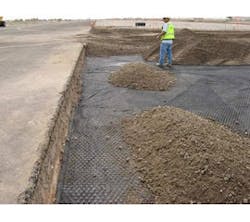The Imperial County, Calif., government operates an airport with two runways that supports general aviation and commercial aircraft. In 2009, the county needed to rehabilitate a taxiway to allow the airport to continue to serve this traffic. The county sought an affordable way to create a new taxiway with a superior projected design life.
The location’s unfavorable subgrade soils consisted of lacustrine deposits, which varied from lean to fat clay (CL to CH) and silt (ML). Shallow groundwater also created pockets of extremely soft soils. To combat this, the county initially considered using a 19-in-thick aggregate base with and without lime stabilization. Both of these options were rejected because of concerns over cost, construction scheduling and lifecycle performance.
Instead, the county decided to use the Spectra Roadway Improvement System—a mechanically stabilized layer incorporating TriAx Geogrid—as a lower-cost, longer-lasting alternative to installing a very thick base layer or remediating the subgrade with lime.
“Our client had used Geogrid on another airport project,” said Geotechnics Inc. Project Engineer Matt Fagan. “The client believed that the use of Geogrid could improve the lifespan of the new taxiway without adding substantial costs to the pavement section.”
Granite Construction began the installation by removing the existing pavement section and 15 in of soil. Next, they leveled and rolled the subgrade and covered it longitudinally with TriAx Geogrid. To complete the installation, they installed 15 in of aggregate base and 4 in of asphalt concrete. In areas with significant groundwater, they excavated the saturated material and installed a lower layer of TriAx Geogrid, which was covered with recycled asphalt (stockpiled when the original taxiway was removed) to return the subgrade to the required profile depth.
"The TriAx Geogrid’s rib has a higher profile and a unique hexagonal shape that gives 360-degree load distribution,” said Tensar International Corporation Regional Manager Lars Nelson. “These properties allowed the taxiway designer to reduce the aggregate layer by 4 in while still providing superior base confinement and strength.”
“The use of TriAx Geogrid helped us establish a firm and unyielding subgrade throughout the site, which translated to improved relative compaction in the aggregate base and asphalt concrete,” Fagan said.



